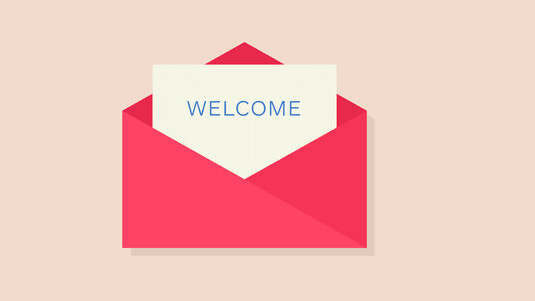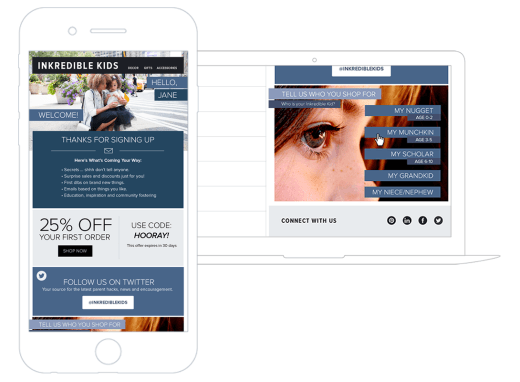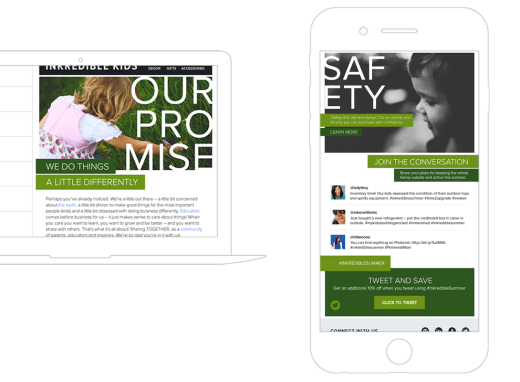
A new subscriber joined your mailing list – congratulations! Now what?
Start at the beginning, with the most important building block of your new relationship: the welcome email. And since you only get one chance to make a first impression, welcome emails carry a lot of weight.
But too often, businesses communicate like nervous teenagers on a first date, creating a negative – even regretful experience.
Welcome emails garner three times the transactions and revenue per email over regular promotional mailings according to Experian. This comparative success tempts many marketers to jam multiple messages and calls to action into one email – leading to a chaotic customer experience.
A welcome email isn’t simply a response to a user action; it’s an opportunity to build a relationship and turn a subscriber into a customer. Here are seven tips and ideas for a well-thought-out welcome email series that creates a customized experience, builds off learnings from previous emails and keeps readers coming back for more.
Email 1: Welcome

Pro tip: Deliver on the promise
On average, consumers receive over 400 commercial emails per month according to Return Path. That’s a tsunami of content to wade through (or delete), so when subscribers decide to add to that and turn their email address over, your obligation and priority must be to deliver on the offer you made.
Whether they joined a program, responded to a deal, or downloaded a piece of content, the first email you send should welcome them in your brand voice and immediately give them unrestricted access to whatever prompted them to sign up in the first place. Making new subscribers jump through additional hoops after they’ve given up their email address is a sure fire way to lose a potential customer.
Pro tip: Set the stage
Your new subscriber has given you something valuable to them in addition to their time and attention: access to their inbox. Let them know it was worth it. Set expectations for what kind of content you’ll send in future emails and how often.
This is a good opportunity to let them know this is a two-way conversation. Start by giving your subscribers a way to share and a sense of community. You can pull in live social feeds to share what your existing fans are saying about your brand in real time.
One tip to avoid the ‘social kiss of death’ is don’t link to your social site’s URL and risk throwing subscribers into a loop of forgotten passwords and unintended troubleshooting. Instead employ deep linking so you can detect if the user has a social app and lead them to the most specific, relevant content or provide a discount/offer to encourage social sharing.
Pro tip: Start profiling
An important component of your welcome series is the data collected along the way. Sending subscribers to a preference center to fill out a personal profile can be a pitfall. Instead take a ‘brick by brick’ approach to build customer profiles with tactics like progressive polling. Progressive polling is a form of gamification that brings customers into the process and allows them to respond to questions over a series of several emails.
You can then use leverage this data in future touches for personalized messaging, product recommendations, offers and more. For example, you may want to find more out about whom your customers buy for and their purchasing behaviors so you can offer tailored content.
Email 2: Establish a relationship

Pro tip: Introduce your story
“People don’t buy what you do, they buy why you do it,” Simon Sinek smartly opines. Your story and vision is important and you should let it shine early on in your email welcome series.
The second email builds on the promise of your first communication. You’ve engaged your new subscribers, they’ve told you more about themselves, now it’s time to share more about what makes your company great and how your values align with theirs. Think about your brand attributes that will resonate most with your subscribers and spur them to act.
Pro tip: Make a connection
The best way to solidify your new relationship with your subscriber is to create an emotional bond. Instead of talking about the features of your products and services, illustrate how your customers benefit. Think about what problems your product solves. How will your customer live differently or better with your product? What is their emotional connection? Let them know that you care about what they care about and then provide additional information to validate your claim.
Pro tip: Provide ongoing social validation
It’s proven that consumers trust the opinions and recommendations of peers. According to WOMMA, word-of-mouth is responsible for $6 trillion of annual consumer spending. Email is a great opportunity to harness this power and provide your subscribers with customer testimonials from your website or social channels. Continue the community building you started with web cropping to pull reviews and testimonials from your website directly into your emails. You can also pull in live social media feeds to include real-time messages from fans.
Email 3: Educate and incentivize

Pro tip: Offer targeted content and deals
The primary objective of this email (and of each email that follows) should be to continue building on the reader’s previous experience. If the reader indicated a preference in the second email’s poll, the third email should offer content that delivers on that preference.
For example: “You told us you were interested in [fill in the blank], so here’s [fill in the blank] for you.” Even if they’ve chosen not to interact with your polls – add something of value. Work off your list of what’s most important to them about your brand. Link them to items of interest on your blog, social media, or use a web crop to pull in relevant resources from your website.
Whatever you do, keep the call to action one-click. This provides the best user experience and increases the chances they’ll follow through.
If you’ve successfully gathered data on your subscribers’ purchasing habits and preferences through polling, you can now offer even more targeted offers, deals and incentives. Welcome email series with coupons have up to two and a half times higher transaction rates. Present a clear call-to-action that’s connected to a seamless destination page experience.
Make the most of “welcome”
Extending a “Welcome!” is a unique opportunity to build a strong and lasting relationship with your customer. With a well-thought-out series of emails – that tells your story, garners subscriber preferences collected over time, you begin to build a connection that drives action. Combine that with a personalized, satisfying user experience and content that’s relevant to their needs and interests, and you have created a loyal, lifetime customer.
Read next:
Get the TNW newsletter
Get the most important tech news in your inbox each week.





